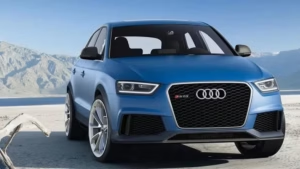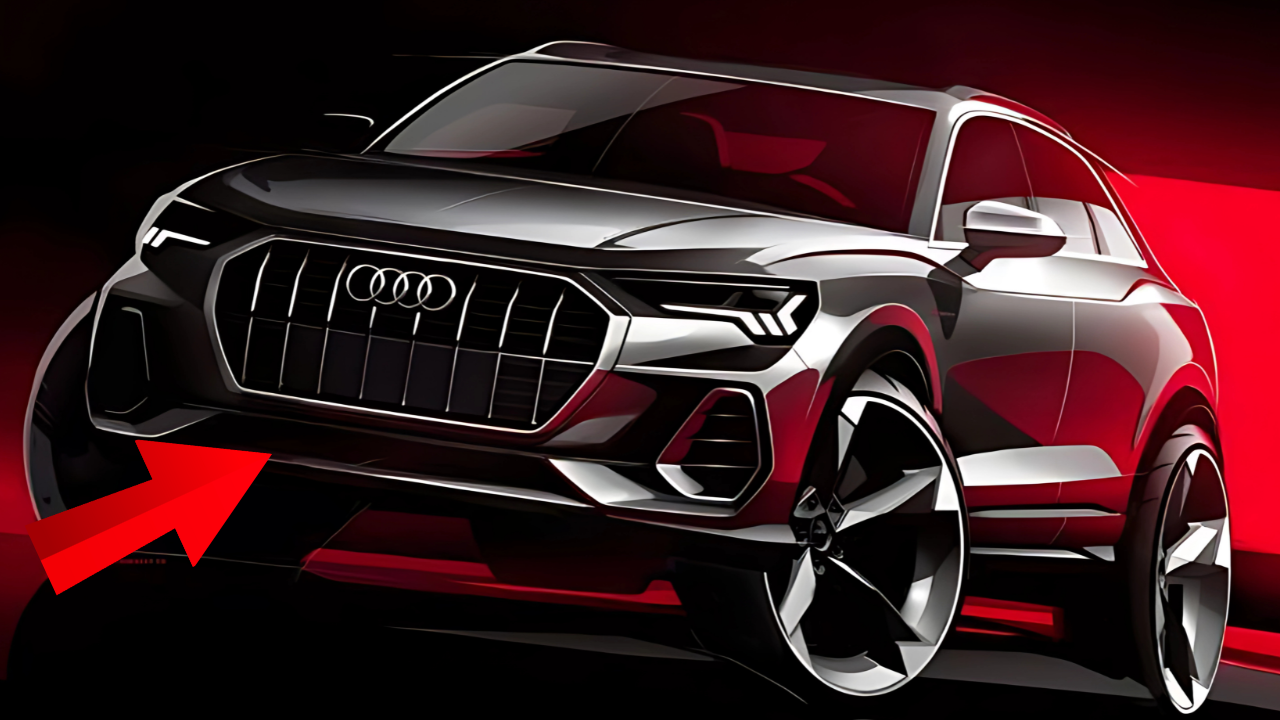Audi has unveiled the third-generation 2025 Audi Q3, a compact luxury SUV that sets new benchmarks in efficiency, driving dynamics, and technology. Launched globally in June 2025, the Q3 builds on its legacy as one of Audi’s best-selling models, with over two million units sold since its debut in 2011. The all-new Q3 combines a muscular exterior, advanced mild-hybrid and plug-in hybrid (PHEV) powertrains, and a tech-laden interior to compete fiercely against rivals like the BMW X1, Mercedes-Benz GLA, and Volvo XC40. With a starting price of €44,600 in Germany (approximately $47,500 USD or $65,000 AUD), the Q3 offers a compelling mix of premium features and practicality. This article delves into the Q3’s design, powertrains, technology, and market positioning, highlighting why it’s a standout in the crowded compact SUV segment.
Bold and Muscular Exterior Design
The 2025 Audi Q3 introduces a striking redesign, drawing inspiration from its larger sibling, the Q5. Its exterior exudes confidence with a wider Singleframe grille, sleek Matrix LED headlights featuring micro-LED technology, and pronounced wheel arches. The clamshell-style bonnet with sharp hoodlines and a horizontal shoulder line create a dynamic silhouette, while 11 vibrant color options—including new Sage Green and Madeira Brown in matte finish—offer personalization. Wheel sizes range from 17 to 20 inches, with sporty designs enhancing its aggressive stance. The aerodynamic sculpting ensures efficient airflow, reducing drag and improving fuel economy, aligning with Audi’s focus on sustainability.
The Q3’s lighting system is a technological highlight, with micro-LED Matrix headlights comprising 25,600 LEDs for adaptive, high-resolution illumination. A distinctive 23-LED segment light signature makes the Q3 instantly recognizable, while the headlights integrate with driver-assistance systems for enhanced safety. The optional black exterior package and S-line equipment add a sportier edge, appealing to buyers seeking a bold aesthetic.
Interior: Digital and Functional Elegance
Inside, the 2025 Q3 elevates compact luxury with a redesigned cabin that prioritizes usability and comfort. The interior features a 10.25-inch Virtual Cockpit digital gauge cluster and an 8.8-inch touchscreen infotainment system, seamlessly integrated into the dashboard. Audi’s “technical elegance” shines through with angular design elements, high-quality materials, and optional acoustic glazing for a quieter ride. A new multifunction lever replaces the traditional gear shifter, freeing up center console space, while physical climate controls remain intuitive.
The Q3 offers 488 liters of cargo space, expandable to 1,386 liters with folded rear seats, making it practical for families. Rear seats slide and recline for added versatility, though cargo capacity trails the BMW X1’s 25.74 cubic feet. Front-row passengers enjoy power-adjustable seats, while rear legroom is adequate but less spacious than rivals like the Volvo XC40. The optional Sonos premium audio system with 15 speakers and 680 watts transforms the cabin into a concert hall, enhancing the premium experience.
Powertrains: Efficiency Meets Performance
Audi’s commitment to efficiency is evident in the Q3’s diverse powertrain lineup, including mild-hybrid, plug-in hybrid, and diesel options. The base 1.5L TFSI petrol engine with 48V mild-hybrid technology delivers 150 hp and 250 Nm, featuring a Cylinder on Demand (COD) system for improved fuel economy. A 2.0L quattro petrol engine produces 260 hp and 400 Nm, while a 2.0L TDI diesel offers 150 hp and 360 Nm, catering to long-distance drivers. The standout is the Q3 e-hybrid PHEV, combining a 1.5L petrol engine, a stronger electric motor, and a 25.7-kWh battery for a combined 272 hp and 400 Nm. It boasts an electric-only range of up to 119 km (WLTP), with 50 kW DC fast charging from 10% to 80% in 30 minutes.
The following table summarizes the 2025 Audi Q3’s powertrain options:
|
Powertrain |
Output |
Torque |
Transmission |
Fuel Economy (WLTP) |
Electric Range (PHEV) |
|---|---|---|---|---|---|
|
1.5L TFSI Mild-Hybrid |
150 hp |
250 Nm |
7-speed S tronic |
~6.5 L/100km |
N/A |
|
2.0L TFSI Quattro |
260 hp |
400 Nm |
7-speed S tronic |
~7.8 L/100km |
N/A |
|
2.0L TDI Diesel |
150 hp |
360 Nm |
7-speed S tronic |
~5.2 L/100km |
N/A |
|
1.5L PHEV e-hybrid |
272 hp (combined) |
400 Nm |
6-speed S tronic |
~1.5 L/100km (combined) |
119 km |
The PHEV’s 100+ mpg potential (when regularly charged) makes it ideal for urban commuting, though real-world electric range may vary between 25-35 miles depending on conditions. The mild-hybrid system enhances efficiency by recovering energy during braking, while the diesel remains a niche option for high-mileage drivers.
Driving Dynamics and Suspension
The 2025 Q3’s new adaptive suspension with two-valve damper control strikes a balance between comfort and sporty handling. Drivers can select modes via Audi Drive Select, with Balanced mode optimizing both dynamics and ride quality. Progressive steering, standard across trims, enhances responsiveness at higher speeds while easing low-speed maneuvers. The Quattro all-wheel-drive system, standard on higher trims, ensures confident traction in diverse conditions, though the base 35 TFSI is front-wheel drive for better efficiency.

While the Q3’s handling is agile for its class, it prioritizes comfort over the sportier BMW X1. Reviewers note its smooth ride on 18-inch wheels, though 19- or 20-inch rims may transmit more road imperfections. The Q3’s compact size (177 inches long) makes it nimble in urban settings, with responsive steering and a composed highway demeanor. However, it lacks the zest of an SQ3, which isn’t offered in the U.S.
Advanced Technology and Safety
The Q3’s tech suite rivals higher-end Audi models, positioning it as a “digital companion.” Standard features include wireless Apple CarPlay/Android Auto, a wireless charging pad, and Audi Connect CARE for remote vehicle services. The optional Technology package adds a 12.3-inch digital gauge display and navigation. The infotainment system, praised for its clarity, is simpler than rivals’ but occasionally prone to glitches, a common issue in tech-heavy Audis.
Safety is a strong suit, with standard features like adaptive cruise control, lane-centering steering, blind-spot monitoring, and front/rear automatic emergency braking. The “Trained Parking” system learns specific parking maneuvers, while an interior monitoring camera tracks driver alertness, a first in this segment. The Q3 earns a five-star NHTSA rating but scores “Acceptable” in IIHS side crash tests, with a “Marginal” in moderate front overlap.
Pricing and Trims
The 2025 Q3 is offered in Premium and Premium Plus trims in the U.S., with a base price of $39,800 (including $1,295 destination). In Europe, pricing starts at €44,600 for the 150 hp TFSI, with the PHEV at €49,300. Australian pricing is estimated at $65,000-$80,000 AUD, reflecting local taxes. The Premium trim includes 18-inch wheels, LED lighting, a panoramic sunroof, and leather upholstery, while Premium Plus adds a 360-degree camera, Sonos audio, and ambient lighting. The Black Optic Plus package ($2,000) enhances style with 19-inch black wheels and red-stitched sport seats.
Compared to rivals, the Q3’s base price undercuts the BMW X1 ($40,675) and Mercedes-Benz GLA ($43,000), but its top trims approach the Q5’s $46,695 entry price. The Convenience package ($1,750) is recommended for added value, including a wireless charger and auto-dimming mirror.
Competitive Positioning
The Q3 faces stiff competition in the luxury subcompact SUV segment. The BMW X1 offers superior handling and cargo space (25.74 cu-ft vs. Q3’s 23.7 cu-ft), while the Volvo XC40 excels in ride comfort and interior quality. The Mercedes-Benz GLA boasts a premium cabin but lags in driving dynamics. The Q3’s strengths lie in its value, standard Quattro AWD, and sleek design, though its fuel economy (20/28/23 mpg city/highway/combined) trails rivals like the Lexus NX hybrid. The absence of a full hybrid or electric variant limits its eco-appeal, though the PHEV addresses this in markets like Europe.
Posts on X reflect enthusiasm for the Q3’s redesign and PHEV option, with users praising its “polarizing” look and 75-mile electric range. However, some note its higher maintenance costs and dated second-generation platform in non-PHEV models.
Market Availability and Ownership
The 2025 Q3 hits European showrooms in October 2025, with U.S. and Australian launches expected in early 2026. Production occurs in Győr, Hungary, and Ingolstadt, Germany. Audi offers a three-year/60,000-mile warranty, shorter than BMW’s unlimited-mileage plan or Lexus’ 10-year coverage. Predicted reliability is strong (J.D. Power score: 82/100), though past models faced infotainment and transmission issues. Maintenance costs may be higher than mainstream rivals, a common trait for luxury brands.
In Summary
The 2025 Audi Q3 redefines compact luxury with its bold design, efficient powertrains, and advanced technology. Its mild-hybrid and PHEV options cater to eco-conscious buyers, while the adaptive suspension and Quattro AWD ensure dynamic handling. Though it trails rivals in cargo space and fuel economy, the Q3’s value, premium cabin, and safety features make it a strong contender. As Audi continues its electrification push, the Q3’s PHEV variant positions it as a forward-thinking choice for urban and suburban drivers. For those seeking a stylish, tech-savvy SUV, the Q3 delivers a compelling package. Visit Audi’s website or local dealers for the latest pricing and availability.
